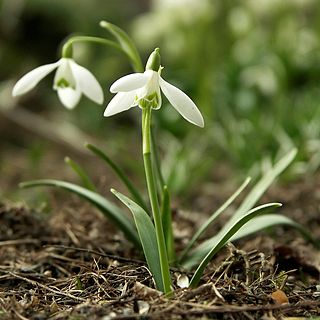
Galanthus is a small genus of approximately 20 species of bulbous perennial herbaceous plants in the family Amaryllidaceae. The plants have two linear leaves and a single small white drooping bell shaped flower with six petal-like (petaloid) tepals in two circles (whorls). The smaller inner petals have green markings.

Leucojum is a small genus of bulbous plants native to Eurasia belonging to the Amaryllis family, subfamily Amaryllidoideae. As currently circumscribed, the genus includes only two known species, most former species having been moved into the genus Acis. Both genera are known as snowflakes.
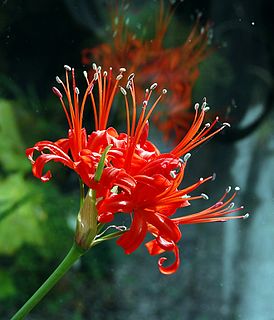
Nerine is a genus of flowering plants belonging to the family Amaryllidaceae, subfamily Amaryllidoideae. They are bulbous perennials, some evergreen, associated with rocky and arid habitats. They bear spherical umbels of lily-like flowers in shades from white through pink to crimson. In the case of deciduous species, the flowers may appear on naked stems before the leaves develop. Native to South Africa, there are about 20–30 species in the genus. Though described as lilies, they are not significantly related to the true lilies (Liliaceae), but more closely resemble their relatives, Amaryllis and Lycoris. The genus was established by the Revd. William Herbert in 1820.

Brunsvigia is a genus of African flowering plants in the family Amaryllidaceae, subfamily Amaryllidoideae. It contains about 20 species native to southeastern and southern Africa from Tanzania to Cape Province.

Acis is a genus of perennial, herbaceous and bulbous plants in the amaryllis family. The genus consists of nine species distributed in Europe and Northern Africa. Acis was previously included in Leucojum; both genera are known as snowflakes.

Esprit Requien was a French naturalist, who made contributions in the fields of conchology, paleontology and especially botany.

Scadoxus membranaceus is a flowering plant in the Amaryllidaceae family. It is a bulbous plant from South Africa. The smallest of the species of Scadoxus, it is sometimes cultivated as an ornamental plant where a minimum temperature of 5 °C (41 °F) can be maintained.
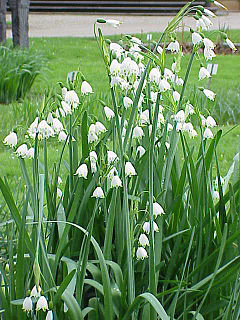
Leucojum aestivum, commonly called summer snowflake or Loddon lily, is a plant species widely cultivated as an ornamental. It is native to most of Europe from Spain and Ireland to Ukraine, with the exception of Scandinavia, Russia, Belarus and the Baltic Republics. It is also considered native to Turkey, Iran and the Caucasus. It is naturalized in Denmark, South Australia, New South Wales, Nova Scotia and much of the eastern United States.

Leucojum vernum, called spring snowflake, is a perennial bulbous flowering plant species in the family Amaryllidaceae that includes the onions, daffodils and Agapanthus. It is native to central and southern Europe from Belgium to Ukraine. It is considered naturalized in north-western Europe, including Great Britain and parts of Scandinavia, and in the US states of Georgia and Florida. It is cultivated as a spring-flowering ornamental bulbous plant. Usually a single white flower with greenish marks near the tip of each tepal is borne on a stem about 10–20 cm tall, occasionally more.

Galantheae is a tribe of plants belonging to the subfamily Amaryllidoideae of the Amaryllis family (Amaryllidaceae). As of 2017, it contains three genera, although more were included previously. The position of the ovary is inferior.

Gilliesieae is a tribe of herbaceous geophyte plants belonging to the subfamily Allioideae of the Amaryllis family (Amaryllidaceae). Described in 1826, it contains fifteen genera and about eighty species. It has been variously treated as a subfamily or tribe. It is native to the Southern United States, Central and South America, predominantly Chile. Of the three tribes of genera that make up the subfamily Allioideae, Gilliesieae is the largest and most variable. The tribe was divided into two tribes in 2014, Gilliesiae s.s. and Leucocoryneae, based on differences in floral symmetry and septal nectaries.

Acis autumnalis, the autumn snowflake, is a species of flowering plant in the family Amaryllidaceae. A short bulbous perennial, it is found on the western shores of the Mediterranean, from Spain and Morocco to Sicily and Tunisia.
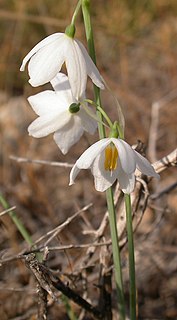
Acis ionica is a species of flowering plant in the family Amaryllidaceae, native from south-western Albania to western Greece. It was initially confused with what is now Acis valentina, a species found in Spain near Valencia.

Acis longifolia is a species of flowering plant in the family Amaryllidaceae, endemic to Corsica. Its white flowers appear in spring. It is sometimes cultivated as an ornamental plant, but is not fully frost-hardy.
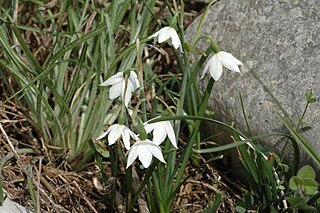
Acis nicaeensis, sometimes called the French snowflake, is a species of flowering plant in the family Amaryllidaceae, native to south-eastern France. A small spring flowering bulb with white flowers, it is cultivated as an ornamental plant.

Acis tingitana is a species of flowering plant in the family Amaryllidaceae, native to north Morocco. Rare in cultivation, it is not fully frost-hardy.
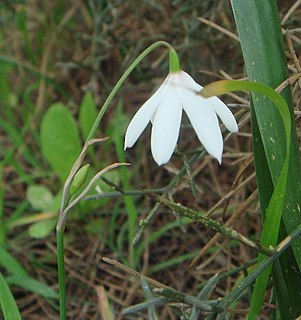
Acis trichophylla is a species of flowering plant in the family Amaryllidaceae, native to Portugal, Spain and Morocco. It has very narrow leaves. The flowers are produced in late winter or early spring and are usually white, but sometimes pink-tinged or all pink. The species is cultivated as an ornamental bulb, but requires protection from hard frost.
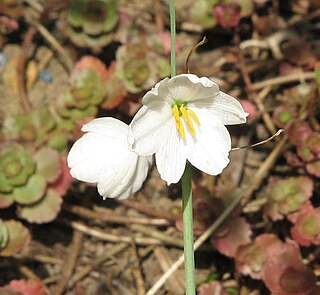
Acis valentina is a species of bulbous flowering plant in the family Amaryllidaceae, native to eastern Spain. Its white flowers appear in autumn. It can be grown as an ornamental bulb, but may need protection from hard frost.
Acis rosea, known as the rose snowflake, is a species of flowering plant in the family Amaryllidaceae, native to Corsica and Sardinia. Unlike most members of the genus Acis, it has pink rather than white flowers. It is grown as an ornamental plant but requires protection from frost.

Galanthus reginae-olgae, Queen Olga's snowdrop, is a species of flowering plant in the family Amaryllidaceae, native to Sicily and the west and north-west Balkans. Some variants produce their pendant white flowers in autumn, others in winter and early spring. It is cultivated as ornamental bulbous plant, preferring warmer situations in the garden than other species of Galanthus (snowdrops).


















